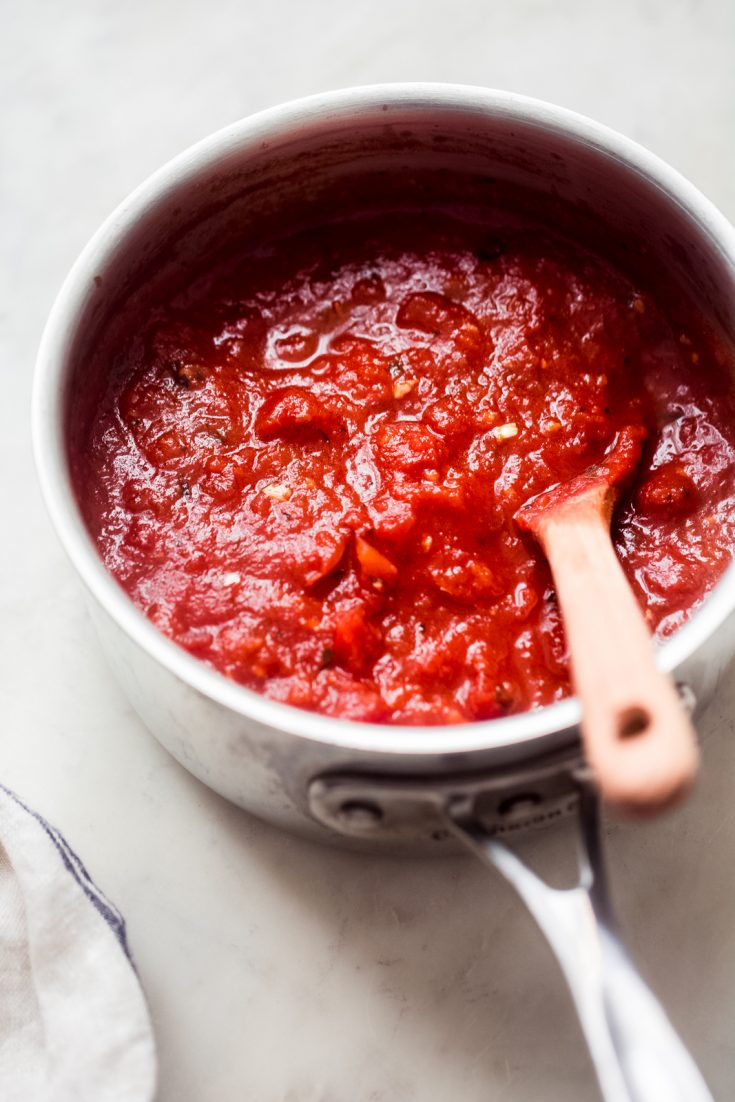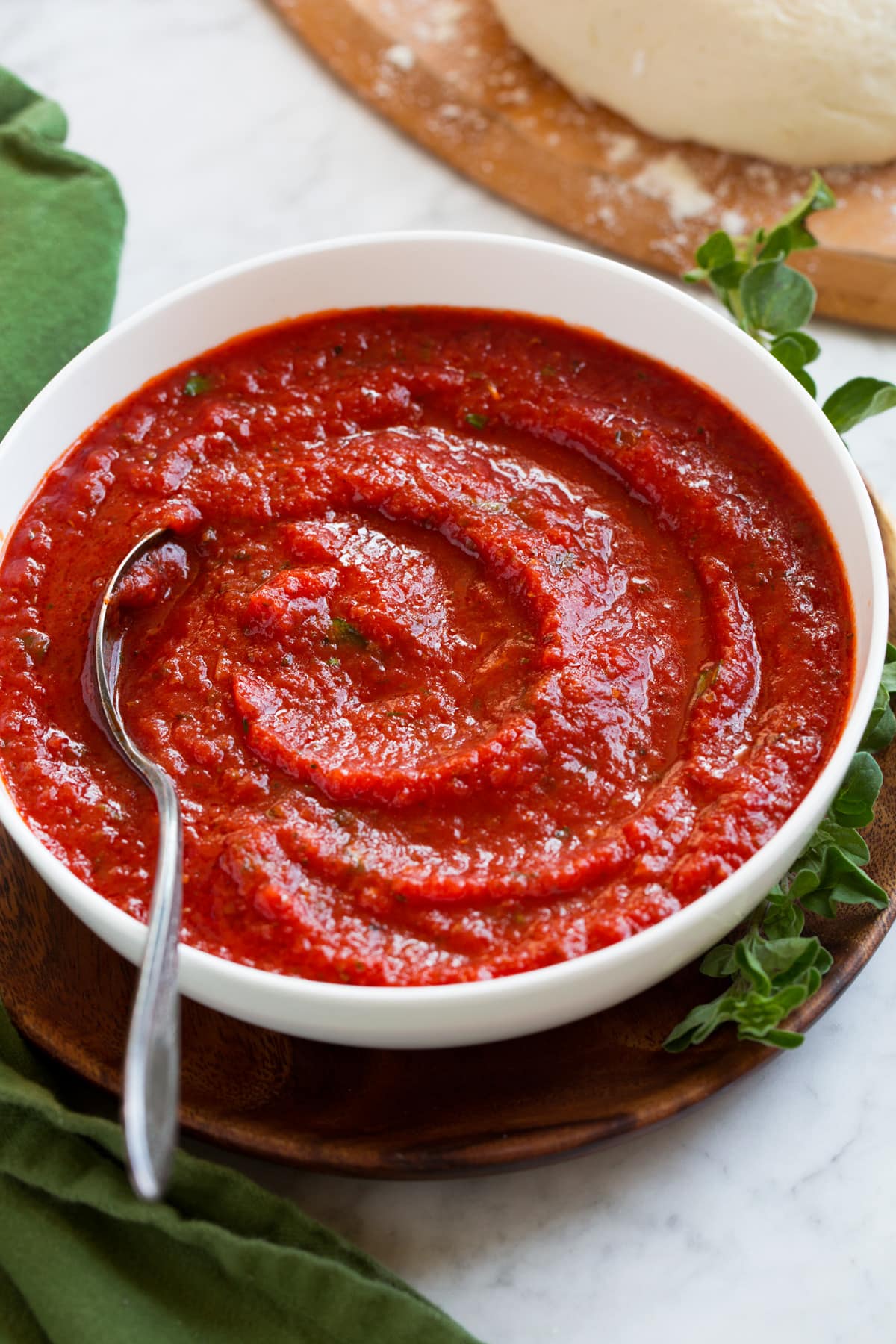How Do You Make Pizza Sauce?

How Do You Make Pizza Sauce? To make pizza sauce, blend tomatoes, olive oil, garlic, herbs, salt, and pepper until smooth. Simmer for 15-20 minutes.
Are you ready to elevate your homemade pizza game? One of the key components of a delicious pizza is the sauce. Whether you prefer a classic marinara or a spicy arrabbiata, the sauce sets the foundation for a flavorful and satisfying pie.
Making your pizza sauce is not only easy but also allows you to customize the flavors to suit your taste preferences. By using simple ingredients like ripe tomatoes, aromatic garlic, and fragrant herbs, you can create a rich and savory sauce that will take your homemade pizzas to the next level. In this blog post, we will explore how to make pizza sauce from scratch and share some tips for achieving the perfect consistency and flavor.
The Quest For The Perfect Pizza Sauce
The quest for the perfect pizza sauce is all about balancing taste and texture. It’s about searching for authentic flavors that enhance the overall pizza experience. The sauce should be the star of the show, complementing the crust, cheese, and toppings.
When making pizza sauce, it’s important to use fresh, high-quality ingredients. Start with ripe tomatoes, garlic, and herbs like basil and oregano. Simmer the ingredients together to develop a rich and flavorful sauce.
One key tip is to find the right balance between sweetness and acidity. Too much sweetness can overpower the other flavors, while too much acidity can make the sauce too tangy. Taste as you go and adjust accordingly.
Remember, the perfect pizza sauce is a personal preference, so feel free to experiment and tailor it to your liking. Whether you prefer a chunky or smooth sauce, the goal is to create a delicious base that brings out the best in your pizza.
The Foundation Of Flavor
The foundation of flavor for any good pizza lies in the sauce. Choosing the right tomatoes is crucial to creating the perfect pizza sauce. When it comes to selecting tomatoes, the debate between using fresh or canned tomatoes is ongoing. Fresh tomatoes offer a vibrant, seasonal flavor, while canned tomatoes provide consistency and convenience. Both options have their merits, and the choice ultimately depends on personal preference and the desired flavor profile. When making pizza sauce, it’s important to consider the characteristics of each tomato type to achieve the desired taste and texture.
Secret Ingredient #1: Infused Oils
| Secret Ingredient #1: Infused Oils |
| Subheading: Creating Herb-Infused Oils |
|
Infused oils can add an extra dimension of flavor to your pizza sauce. Here are some best practices to follow when creating herb-infused oils:
|
Secret Ingredient #2: The Magic Of Garlic
Garlic enhances pizza sauce flavor. Roasting garlic adds depth. Balancing garlic intensity is crucial. Use roasted garlic for a milder flavor. Raw garlic for bold taste.
Secret Ingredient #3: Unconventional Sweeteners
When making pizza sauce, using unconventional sweeteners can enhance the flavor profile. Alternative sweeteners, such as honey or agave, can provide a unique twist. They also impact the consistency of the sauce. Sweeteners like maple syrup can add a rich, thick texture. On the other hand, using stevia may result in a thinner consistency. Understanding how different sweeteners affect the sauce can help you achieve the perfect balance of flavor and texture for your pizza.
Secret Ingredient #4: Umami Boosters
Enhance pizza sauce with umami-rich ingredients like tomatoes, mushrooms, and Parmesan cheese. Umami adds savory depth to the sauce, making it more flavorful and delicious. Incorporate ingredients gradually to balance flavors and achieve the desired taste. Experiment with different umami boosters to find your perfect pizza sauce recipe.
Secret Ingredient #5: A Splash Of Acidity
When it comes to making pizza sauce, one secret ingredient that can take your recipe to the next level is a splash of acidity. But how do you choose the right acidic component?
| Acidic Component | Impact on Flavor Balance |
|---|---|
| Vinegar | Sharp and tangy, can overpower other flavors if too much is used |
| Lemon Juice | Bright and fresh, adds a subtle citrus flavor |
| Red Wine | Rich and complex, pairs well with tomato flavors |
Ultimately, the acidic component you choose will depend on personal preference and the other flavors in your pizza sauce. Keep in mind that too much acidity can throw off the balance of your sauce, so start with a small amount and adjust to taste.

Simmering And Blending Techniques
To craft delicious pizza sauce, master simmering and blending techniques. Slowly simmer fresh tomatoes with garlic and herbs, then blend until smooth for a flavorful sauce base. Mix in olive oil and seasonings for the perfect pizza topping.
| Simmering and Blending Techniques |
| The Art of Simmering |
| Simmering is a crucial step in making pizza sauce. It involves cooking the sauce over low heat for a long time, allowing the flavors to meld together. To start, combine your tomato sauce, crushed tomatoes, and seasonings in a pot. Bring it to a boil, then reduce the heat to low and let it simmer for at least an hour. Make sure to stir occasionally to prevent burning. |
| To Blend or Not to Blend |
| Some pizza sauce recipes call for blending the ingredients after simmering, while others do not. Blending the sauce can create a smoother texture, but it’s not necessary. If you prefer a chunkier sauce, you can skip this step. If you do decide to blend, allow the sauce to cool slightly before transferring it to a blender or food processor. Blend until you reach your desired consistency. |
Preservation And Storage Tips
Preservation and Storage Tips for pizza sauce include the following:
- Store in airtight containers for freshness.
- Refrigerate for short-term use within a week.
- Freeze for long-term storage up to 3 months.
- Consider canning for pantry storage.
Best Practices for Longevity:
- Freezing retains flavors and nutrients.
- Canning requires proper sterilization techniques.
- Label containers with dates for tracking.

Putting It All Together: Making Your Sauce Stand Out
When making pizza sauce, it’s important to strike the right balance of flavors. Consider adding a pinch of sugar to balance the acidity of the tomatoes. You can also experiment with different herbs like oregano, basil, and thyme to enhance the flavor profile. Additionally, a dash of red pepper flakes can add a subtle heat to the sauce. Moreover, don’t forget to let the sauce simmer to allow the flavors to meld together. In addition, taste the sauce as you go and make adjustments to suit your preferences.

Frequently Asked Questions
What Is Pizza Gravy Made Of?
Pizza gravy is typically made of crushed tomatoes, garlic, olive oil, salt, and herbs such as basil and oregano. Some recipes may also include sugar or red pepper flakes for added flavor.
How Do I Substitute Pizza Sauce?
You can substitute pizza sauce with marinara sauce, pesto, or BBQ sauce for a unique flavor. Alternatively, try olive oil or hummus for a lighter option.
How To Make Pizza Sauce Better?
To make pizza sauce better, try adding a pinch of sugar to balance the acidity, a dash of dried oregano for added flavor, and a splash of olive oil for richness. Don’t forget to simmer the sauce for at least 20 minutes to enhance the flavors.
Enjoy your delicious pizza!
How Does Gordon Ramsay Make Pizza Gravy?
Gordon Ramsay makes Pizza gravy by blending San Marzano tomatoes, olive oil, garlic, salt, and basil. He lets it simmer for 20 minutes.
Conclusion
Making Pizza gravy is a simple and rewarding process. By using fresh ingredients like tomatoes, herbs, and spices, you can create a delicious sauce that enhances the flavor of your homemade pizzas. Remember to adjust the seasoning to your taste and experiment with different ingredients to find your perfect sauce recipe.
Making your Pizza gravy allows you to customize your pizzas and adds a personal touch to your culinary creations. So, why not give it a try and elevate your pizza-making game?






